
Although traditionally the 'capital' of the Het Gooi region, Hilversum was a largely agricultural village until the 18th century. In the late-19th century its railroad connections with Utrecht and Amsterdam lead to organised tourism and the settlement of wealthy citizens from Amsterdam. After 1918 Hilversum became the centre of public radio broadcasting. By that time architect W.M. Dudok turned the village into a modern city. Most of the churches in the city were built after 1900, with especially Expressionism being well represented.
Hoewel van oudsher de hoofdplaats van Het Gooi, was Hilversum tot de 18e eeuw een grotendeels agrarisch dorp. Aan het eind van de 19e eeuw leidden treinverbindingen met Utrecht en Amsterdam tot georganiseerd toerisme en de vestiging van rijke burgers uit Amsterdam. Na 1918 werd Hilversum et centrum van de publieke radio-omroep. Tegen die tijd onderging het dorp onder leiding van architect W.M. Dudok een metamorfose tot een moderne stad. Het merendeel van de kerken in de stad werd gebouwd na 1900, waarbij vooral het expressionisme sterk is vertegenwoordigd.

The Reformed church is the successor of the medieval church of St. Vitus, of which only the tower remains. The old church replaced by a new church in neo-Renaissance style in 1891, designed by J. Wolbers.
Location: Kerkbrink 4
De Hervormde kerk is de opvolger van de middeleeuwse St. Vitus waarvan alleen de toren nog bestaat. De oude kerk werd in 1891 vervangen door een kerk in neorenaissance stijl, ontworpen door J. Wolbers.
Location: Kerkbrink 4

The Old-Catholic St. Vitus is a remarkable building in a neo-Baroque style, designed by P.A. Weeldenburg and built in 1888-1889.
Location: Melkpad 12
De Oud-Katholieke St. Vitus is een opvallend gebouw in neobarokke stijl, ontworpen door P.A. Weeldenburg en gebouwd in 1888-1889.
Locatie: Melkpad 12

The Roman Catholic St. Vitus is a big five-aisled Neo-Gothic church designed by P.J.H. Cuypers and built in 1891-1892. It is regarded as one of Cuypers' most important works.
Location: Emmastraat 5
De Rooms-Katholieke St. Vitus is een grote vijfbeukige neogotische kerk, gebouwd in 1891-1892 naar een ontwerp van P.J.H. Cuypers. Ze is een van diens belangrijkste werken.
Location: Emmastraat 5

The Gereformeerde kerk or Torenlaankerk is a three-aisled building in Neo-Renaissance style. It was designed by D. Kuipers and was built in 1896. It's nowadays used by a publishing house.
Location: Torenlaan 25
De Gereformeerde kerk of Torenlaankerk is een driebeukig gebouw in neorenaissance stijl. Het werd ontworpen door D. Kuipers en werd gebouwd in 1896. Het gebouw wordt tegenwoordig gebruikt door een uitgeverij.
Locatie: Torenlaan 25
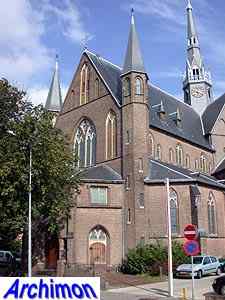
Another Roman Catholic church is the O.L. Vrouwe Onbevlekte Ontvangenis ('Our Lady Immaculate Conception'). This church, designed by W. te Riele, was built in 1910 and mixes neo-Gothicism with a centralizing ground-plan.
Location: Koninginneweg 40
Een andere rooms-katholieke kerk is de O.L. Vrouwe Onbevlekte Ontvangenis. Deze kerk, ontworpen door W. te Riele, werd gebouwd in 1910 en combineert neogotiek met een centraliserende plattegrond.
Location: Koninginneweg 40
 The
church of the Gereformeerde Gemeente was designed by B.H. Bakker and built in
1921. It is transformed into apartments for the mentally handicapped.
The
church of the Gereformeerde Gemeente was designed by B.H. Bakker and built in
1921. It is transformed into apartments for the mentally handicapped.
Location: Albertus Perkstraat 4
De kerk van de Gereformeerde Gemeente is ontworpen door B.H. Bakker en stamt uit 1921. De kerk wordt omgebouwd in appartementen voor verstandelijk gehandicapten.
Locatie: Albertus Perkstraat 4
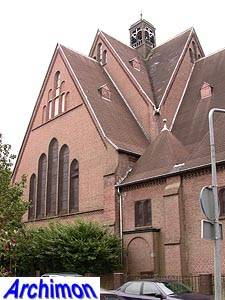
In its original form after its construction in 1913-1914, the St. Clemens Maria Hofbauer was a centralizing church in Neo-Romanesque style. It was designed by J. van Gils. In 1921-1922 its nave was lenghtened by J.Th.J. Cuypers.
Location: Bosdrift 55
In zijn oorspronkelijke vorm na de bouw in 1913-1914, was de St. Clemens Maria Hofbauer een centraalbouw in neoromaanse stijl. Zij werd ontworpen door J. van Gils. In 1921-1922 werd het schip verlengd door J.Th.J. Cuypers.
Locatie: Bosdrift 55

Built in 1922-1923, the Gereformeerde Zuiderkerk is one of the oldest churches in Expressionist style in Hilversum. It was designed by A. de Maaker. Plans to demolish the church and mutilate the tower have been abandoned. It's now an international evangelical church.
Location: Neuweg 148
De uit 1922-1923 stammende Gereformeerde Zuiderkerk is een van de oudste kerken in expressionistische stijl in Hilversum. Het gebouw werd ontworpen door A. de Maaker. Plannen om de kerk te slopen en de toren te verrminken zijn van de baan. Het is nu een internationale evangelische kerk.
Locatie: Neuweg 148

The smallest church in Hilversum is the evangelical Bethelkerk or, its current name, Silokerk. The building was built as a school in 1898 and was transformed into a church in 1923.
Location: Zadelstraat 3
De kleinste kerk in Hilversum is de evangelische Bethelkerk ofwel, haar huidige naam, de Silokerk. Het gebouw werd gebouwd als een school in 1898 en werd in 1923 omgebouwd tot een kerk
Locatie: Zadelstraat 3

The Evangelical Lutheran church is in the Expressionist style of the Amsterdam School. It was designed by J. Dullaart and dates from 1923.
Location: Bergweg 6
De Evangelisch-Lutherse kerk is in de expressionistische stijl van de Amsterdamse School. Zij werd ontworpen door J. Dullaart en dateert uit 1923.
Location: Bergweg 6
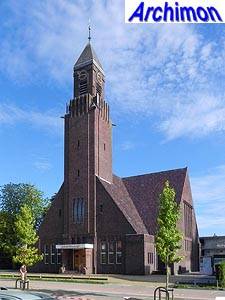
The reformed Diependaalse kerk was designed in Expressionist style by D.A. van Zanten and built in 1925.
Location: Diependaalselaan 138
De hervormde Diependaalse kerk werd in expressionistische stijl ontworpen door D.A. van Zanten en is gebouwd in 1925.
Locatie: Diependaalselaan 138

The Tesselschadekerk of the liberal Nederlandse Protestantenbond is another church in Expressionist style. It was designed by B.H. Bakker en H. Bunders and built in 1927.
Location: Tesselschadelaan 17
De Tesselschadekerk van de vrijzinnige Nederlandse Protestantenbond is eveneens een kerk in expressionistische stijl. Zij werd ontworpen door B.H. Bakker en H. Bunders en is gebouwd in 1927.
Locatie: Tesselschadelaan 17
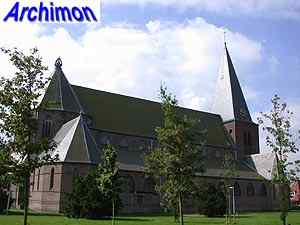
The Heilig-Hartkerk is a Roman Catholic church designed in Traditionalist style by H.W. Valk and built in 1927-1928.
Location: P.J.H. Cuypersplein 5
De Heilig-Hartkerk is een rooms-katholieke kerk, ontworpen in traditionalistische stijl door H.W. Valk en gebouwd in 1927-1928.
Locatie: P.J.H. Cuypersplein 5

Another example of Expressionism is the church of the Vrije Evangelische Gemeente, who formerly used the Bethelkerk. The church was designed by A.D.R. Blok and was built in 1931.
Location: Taludweg 35a
Een ander voorbeeld van expressionisme is de kerk van de Vrije Evangelische Gemeente, die eerder de Bethelkerk gebruikte. De kerk werd ontworpen door A.D.R. Blok en werd gebouwd in 1931.
Locatie: Taludweg 35a
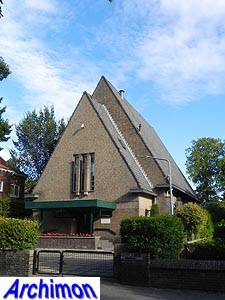
In a similar but simpler style is the church of the Vrijzinnige Protestanten ('liberal protestants'), which is nowadays used by the Jehovah's Witnesses.This church dates from 1932.
Location: Frans Halslaan 57a
In een soortgelijke, maar eenvoudiger stijl is de kerk van de Vrijzinnige Protestanten, die tegenwoordig wordt gebruikt door de Jehovah's Getuigen. De kerk stamt uit 1932.
Locatie: Frans Halslaan 57a

The catholic St. Joseph was built in 1935-1936 and is in Traditionalist style. It was designed by N. Andriessen. Ít was converted into apartments in 1994.
Location: Pelikaanstraat 32
De katholieke St. Joseph werd gebouwd in 1935-1936 en is in traditionalistische stijl. De kerk werd ontworpen door N. Andriessen. In 1994 werd de kerk omgebouwd tot appartementen.
Locatie: Pelikaanstraat 32